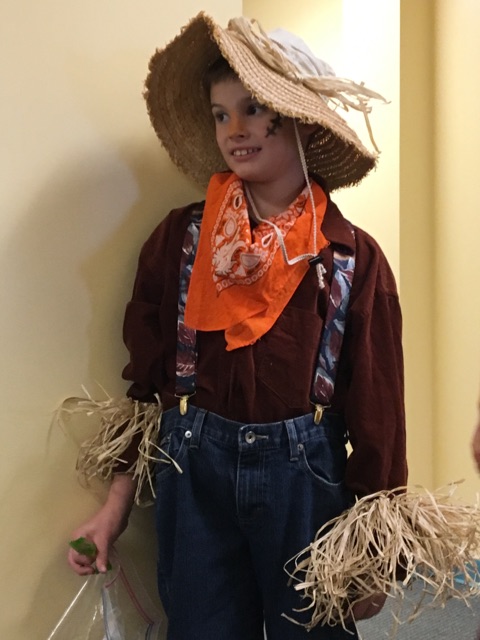
Published on: October 26, 2017
Halloween is really fun holiday that many children look forward to all year long. However, there can be a number of challenges for our kiddos, who are on the spectrum, during this holiday. One challenge (usually the biggest one) is wearing the costume. Costumes feel and look very different from what they usually wear. It is often a struggle to get them to wear a costume – especially if it has a hat or some type of head piece. Another challenge is learning all of the steps involved in trick-or-treating. It may seem simple but these steps (knocking on the door/ ringing the door bell, saying “trick-or-treat” or holding out a bag, and selecting one or two pieces of candy) need to be taught and practiced with our kiddos before going trick-or-treating. Walking around the neighborhood may also be a challenge for some kiddos.
In order to prepare for this fun holiday, we should address all of these challenges before Halloween. So, how can we do that? See below for ways to work on each of the challenges:
Wearing a Costume:
The first step for this is to pick a costume. Allow your child to be involved in picking which costume he or she wants. If it is difficult for them to make a choice, give them 2 to 3 choices to pick from. If they are a part of picking the costume and excited about the costume, they will be much more likely to want to wear it.
After you get the costume, allow your child to explore their costume before wearing it on Halloween. This includes playing with the costume, seeing you wear the costume, dressing others in the costume (e.g., sibling, stuffed animal, doll), and putting on small pieces of the costume at a time. Talk about how awesome the costume is while they are exploring it. When they put the costume on make sure to have a mirror available so they can see themselves in the costume. You may see how cute it looks but if they cannot see it, then all they see and feel is a fabric or accessory that they are not used to wearing.
If they are hesitant wearing the costume (or a piece of the costume), have them wear it for small periods of time. For example, you can say, “You are going to wear the hat for 10 seconds. [Put hat on] Let’s count 1, 2, 3, 4, 5, 6, 7, 8, 9, 10.” Then remove the costume/part of costume and provide lots of verbal praise for doing so. Increase the amount of time wearing it as they become more comfortable with it.
Trick-or-treating:
We teach our kiddos by breaking larger skills into smaller pieces, so we need to do the same thing with the skill of trick-or-treating – practice all the steps involved one at a time.
- First, practice knocking on a door or ringing a door bell. You can take your kiddo outside and have someone inside to answer the door. Prompt them (verbally, by model, physically) to knock on the door or ring the doorbell. Have the person inside open the door immediately upon hearing the knock or the bell and provide lots of reinforcement (e.g., verbal praise, tickles, an edible) for knocking on the door or ringing the doorbell. Practice this multiple times across several days. You also want to keep in mind that practicing this may increase the likelihood that your child will want to knock on the door/ring the door bell a lot more after practicing this and outside of the context of trick-or-treating. Make sure to emphasize that you do this at Halloween and if it becomes an issue with wanting to do so more frequently, please consult your BCBA (Board Certified Behavior Analyst) about ways to decrease this behavior.
- Next, practice saying “trick-or-treat” or giving another individual a picture that says “trick-or-treat.” You can practice saying this phrase if your child communicates vocally or practice handing a picture to another person that says this phrase, if your child communicates non-vocally. As soon as your child communicates this phrase, provide reinforcement in the form of verbal praise and an edible or other tangible item (e.g., sticker, toy). Practice this multiple times across several days.
- Lastly, practice selecting one or two pieces of candy/toys out of a larger set of items. Present your child with a bowl or other container that has a number of items in it and prompt them to pick up one or two of the items. If they select too many, prompt them to put the extra items back. If they select one or two, allow them to have access to those items and provide verbal praise for selecting the items.
Walking in the neighborhood:
Take a walk in your neighborhood (or wherever you will be trick-or-treating) with your child before going trick-or-treating on Halloween. If you do not walk in this area on a regular basis, take the time to do so several times before Halloween so it becomes more of a routine before hand and is not a novel activity. This is also a good time to practice walking on the sidewalk, stopping at Stop signs, and looking both ways before crossing the street!
With all of this practice ahead of time, going trick-or-treating should be a lot easier for our kiddos once they have practiced the full routine and had so much fun in the process! We will be practicing all of these steps before and during our Fall Festival next Tuesday, October 31st and are so excited to see all of the kiddos in their costumes, trick-or-treating successfully, and having fun!
By Anne Stull, M.A., LPA, BCBA
For more information on The Shafer Center call 410-517-1113